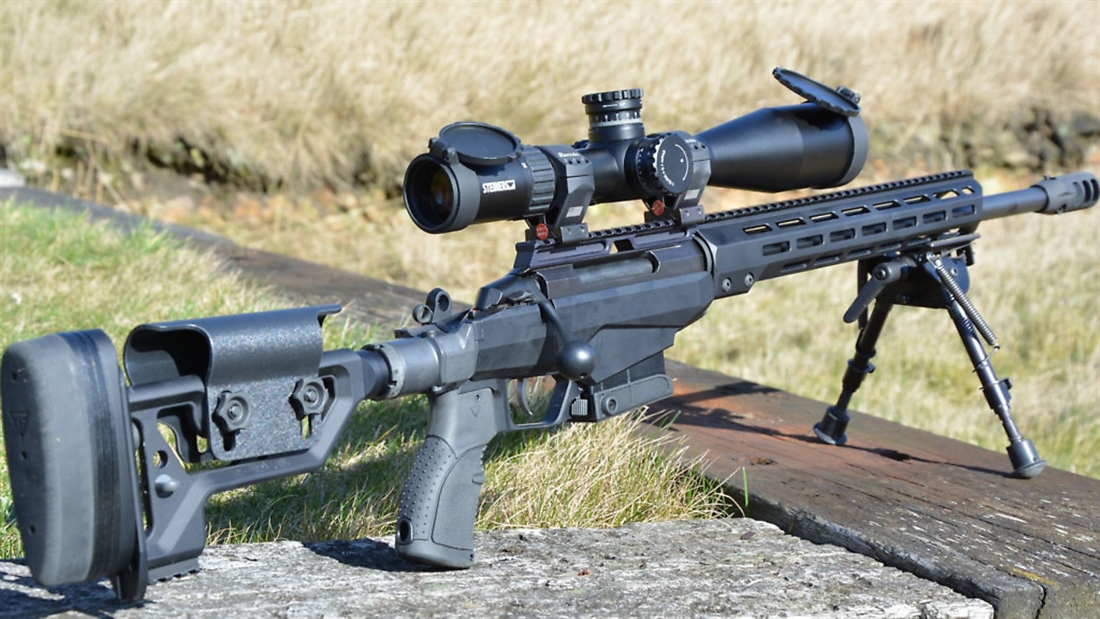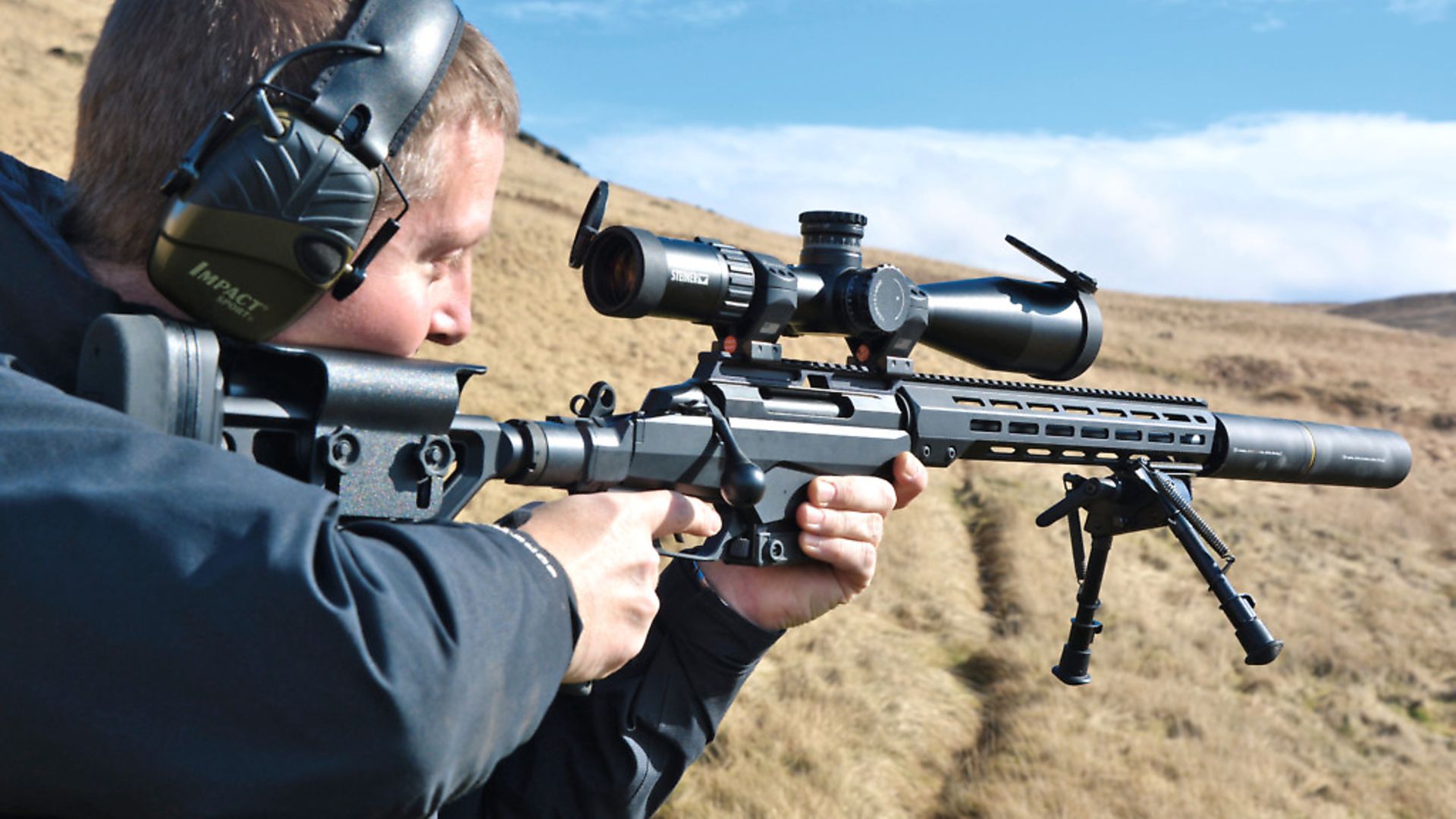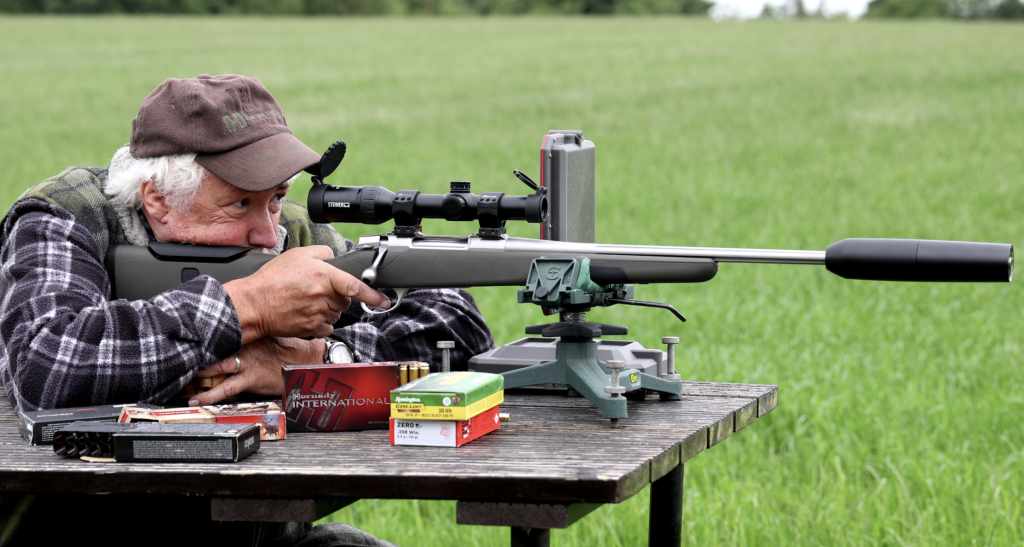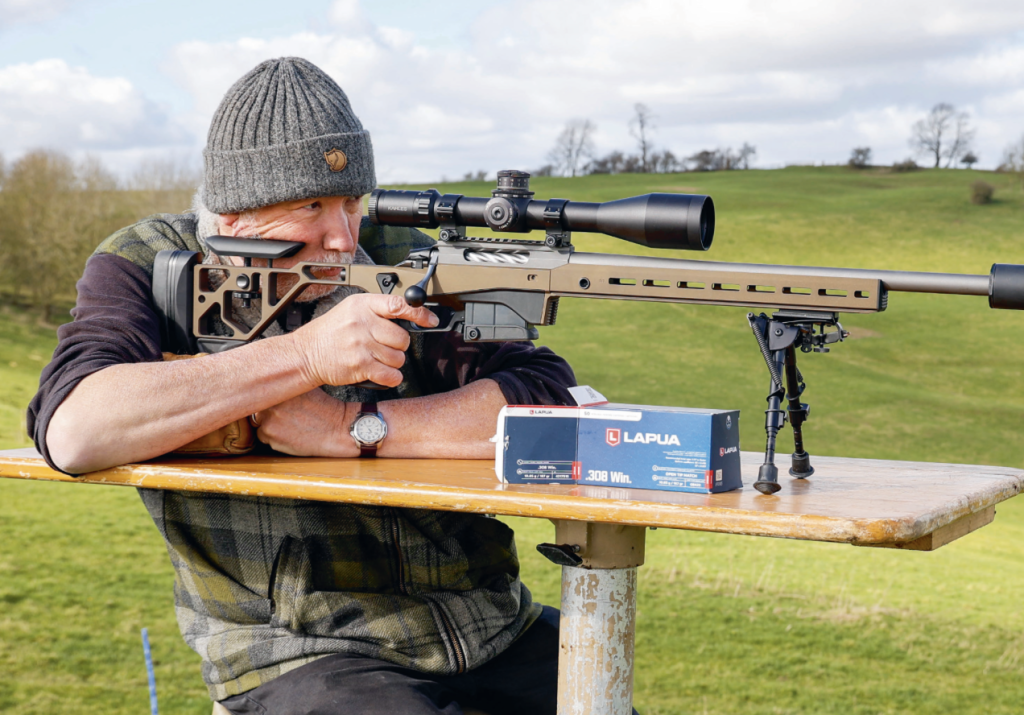Tikka T3x TAC A1 in .308 Winchester – in depth test and review

Chris Parkin puts the Tikka T3x TAC in .308 Winchester to the test… is this beauty leading the growing chassis rifle market?
IN BRIEF
Likes
* The Tikka is a classic action
* Robust build-up of the chassis and action structure
* Predictable consistent trigger capable of rulebook adjustments
* Magazine feed and action cycling of match rounds offering all options
Dislikes
* Short reach from grip to trigger but can be changed with AR15 compatibility
* I like the adjustable cheekpiece, but not the actual shape
* I don’t think 20” barrels get the best from 308 factory ammunition velocity wise
Verdict
*As far as the current trend for chassis rifles evolves, so far the Tikka is the one walking ahead of the rest, and it is the one I would buy. Some will question the zero inclination Picatinny rail, but scope mounts easily solve this. Quality of design and build standards exceeds all I have seen so far
Tikka T3X CTR in 308 Winchester
Overall Length: 1010mm open, 776mm folded
Weight: 4.9kg
Barrel length: 510mm/20” 1 in 11” twist rate
Magazine capacity: Detachable, 10+1
Trigger: Two stage, adjustable from 1000gr to 2000gr (factory set to break at 1800gr)
Stock: Fully CNC machined aluminium chassis system with tubular forend and AR15 compatible grip[ and Buttstock
Screwcut: 16×1 mm
Accessories: Laterally ported Muzzle Brake included
Flat Picatinny rail on action with 340mm extension above forend
Prices
Rifle: £1,880
Steiner Mx5i Scope: £2,350
Stalon W145 Sound Moderator: £346
Burris XTR Signature Scope Rings: £130
Federal 150gr Power Shock Soft Point ammunition: P.O.A.
Contact: GMK, 01489 579999, www.gmk.co.uk
Also used
Lapua 155gr Scenar ammunition
Viking Arms, 01423 780810, www.vikingarms.com
Lapua, Vihtavouri Powders, CCI Primers,
Hannams Reloading, 01977 681639,www.hannamsreloading.com
Ammunition used
Lapua 150gr Mega Soft Point ammunition
Viking Arms, 01423 780810, www.vikingarms.com
Fiocchi 150gr SST ammunition
Edgar Brothers, 01625 613177, www.edgarbrothers.com
Winchester 150gr Extreme Point ammunition,
Browning UK, 01235 514550, www.browning.eu
IN DETAIL
Since the Ruger Precision rifle instigated the trend for what has become known as the ‘chassis rifle’, seemingly everyone – Bergara, Howa, Browning, Winchester and now Tikka – has been running to keep up. Some look good, some not so good, but as supply and demand dictates, I doubt anyone will have any problem selling them to the US market in their thousands. So, just days after IWA, where we first saw one in the flesh, I was delighted to receive a Tikka T3x TAC A1 to review, months ahead of a suggested date, never mind a promised one.
The Tikka action with its minor ‘x’ updates needs little introduction as it’s a superbly well-made gun with a massive following, owed to its effective reliability in whatever format is chosen. The TAC shows the familiar twin-lug push-feed bolt with slick operation (here with a Teflon coating), positive primary extraction, and reliable ejection through the slightly modified ejection port on the otherwise flat-topped action. It has a 25mm ball-ended 68mm handle, which runs its 102mm stroke very fast in the gun, offering approximately 75-degree bolt lift to extract/cock on opening. The first surprise I had was the trigger – now a two-stage unit adjustable from 1-2kg for a crisp break, and adjustable for compliance with competition rules. It slips seamlessly through the first stage, holds confidently against the second, and the gentle additional applied weight of the final squeeze breaks it with full predictability and timing. This is especially good for fire and movement in positions with lesser support, like kneeling or standing, when you want to time those breaks with your inherent drift on target.
The second additional element was the two-position safety catch, locking the bolt closed. It now has an additional lever to its front that, when pressed, allows the bolt handle to lift and the gun to be unloaded when safe, which is a nice touch. The 10-round mag is identical to the CTR I tested a few months ago, but it would seem the spring has been pre-eased, allowing 10 .308 cases to slip into the twin columns with ease. It feeds from either side, and single rounds that are dropped in through the ejection port onto the top of the follower will feed straight into the chamber as well. Just watch out when using some flatter nosed soft points, as these tended to snag a little on the mag’s face and feed ramp when loading – but they aren’t really appropriate to the gun’s design intentions. When I dropped a round way back into the port, the case’s rim did snag on the rear metal rim of the mag on a few occasions, so show due caution and ‘flick’ the rounds in forwards, rather than to the back in a hurry. The ambidextrous mag release wraps the front of the spacious trigger guard surrounding a vertical, serrated 6mm-wide blade. Mags drop free under their own weight without hesitation, and the rubberised base does keep things quiet if that is critical. This neatly machined centre section with the action bedding and mag well is the hub of the whole gun, and is smartly hard-anodised in smooth matt black for a durable feel to match the rest of the gun’s construction. All the components slotted and bolted together like Lego, with no need to force anything at the multiple areas of interlocking bolts and recoil lugs. Multiple sections that interlock with each other will soon show up poor machining or design tolerances, and the Tikka had none of these, with all bolts lining up perfectly and spinning into place finger-tight with no need for tools, until finally nipping them tight.
A Picatinny rail is bolted in four places above the still-present dovetails of the T3x’s action. It shows zero inclination, which some users might baulk at, but this does allow it to line up correctly with the additional 340mm of rail that runs along the octagonally tubular fore-end. This is a serious point – I have seen plenty of rifles with a 20 MOA rail on the action that meets a flat one at the front, so whichever way you want to do it there are downsides to linearity, and certainly for some optical items. However, these are unlikely to be seen in a civilian world, with most users of this gun preferring the top-mounted rail for mounting a pendulum-style bipod. Single scope mounts will easily add the inclination you may or may not need, and seriously, in a .308, how much do you need? GMK supplied me with some new Burris XTR Signature 34mm rings, which come with a selection of inserts to add inclination between the mounts; plus, as they work like the older spherical ones on the original Signature rings, they compensate for the inherent misalignment between rings of unknown spacing. Twin base bolts and six ring bolts gave a very secure grip with no possibility of scope damage. They are an excellent product in their own right, and combined with the Steiner MX5i 5-25×56 scope allowed distributor GMK to furnish me with a very capable package for a test gun (more about the Stalon mod later!).
The fore-end shows numerous skeletonised M-Lok cutouts for further accessory mounting and cooling of the fully-floated 20mm-diameter barrel. I added a Harris bipod with an adapter, but was told that future guns will come supplied with a stud to mount the bipod to, and other options will be available to the customer. Mine was factory supplied with a QR sling mount of similar profile to those at the rear of the action tang and buttstock, which weren’t compatible with the age-old, reliable Harris. I would personally spec this gun with some Picatinny add-ons underneath so I could mount my newly favoured Atlas… so keep an eye on what is decided! The fore-end clamps to the barrel/action with twin bolts at its rear which are threaded into stainless steel inserts, rather than bare aluminium, for long-term durability. The front bolt can stay in, the rear one draws out, and it just slides off if you want to disassemble or clean underneath.
An 11” twist rate on the 20” barrel will stabilise the 30 calibre bullets up to 180gr plus, and after bore-scoping the virgin barrel I was struck by the gleaming, blemish-free, hammer-forged tube’s production standards. Shooting the gun proved this to be correct because not only did it shoot well, but it also cleaned out more easily than any other factory barrel I have known; it was more akin to a hand-lapped, cut-rifled match barrel, with very little copper fouling accumulating. The muzzle is threaded 16×1 with a laterally ported brake with mirage band stud that screws on before being nipped into position. This rotational position can be tweaked slightly to personalise the recoil feel and barrel torque that transmits to the shooter. All you need to do is use a pencil to make a witness mark on the junction so you can pop it back into position if you want to remove it for cleaning, which I would do as firing residue always seems to accumulate corrosively on any barrel’s crown when restricted inside a mod or brake. I found the brake effective in cutting recoil from what is a modestly sized and weighted gun, but wouldn’t choose to shoot one here long term; depending on your surroundings, it’s close to your head, and I got that mildly concussed feeling after 45 rounds on the first day’s shooting from the rearward blast pressure wave.
After this, I added the supplied Stalon mod, a unit I had heard great reports about and, to cut a long story short, it deserves every compliment it gets. It is one of the best mods I have ever used. At 456g in weight and 273mm long with 120mm barrel overhang, the mod is strippable for cleaning and is intelligently assembled from new with a heat-resistant anti-galling compound to the fine internal metric threads, preventing it from seizing up. It cut recoil and noise and, when it comes to the three compromising golden rules of mods – recoil and noise versus weight – this one might just be the best yet. I hold nothing back in complimenting its performance.
Behind the AR15 compatible grip, the rear of the aluminium machined centre stock blends into an AR15 buffer tube behind the hinge mechanism, which locks internally, either open or closed. The push-button release catch sits behind/underneath the bolt, which needs pushing forwards to unlatch it. The bolt’s release lever nestles to the left side of the action and is slightly obscured by the cheekpiece when the gun is folded. This isn’t particularly problematic, unless you get very officious range officers who don’t like you having to close the action before you can fold the stock; you have to re-open it a little before removing the bolt. There is a lock ring on the buffer tube so you can make minor adjustments for rotation and length of pull here, but most of the adjustability has been well-designed into the buttstock Tikka supplied. It’s a machined aluminium construction, and though not available in left-handed version, the cheekpiece will flip either side. The butt is supplied with four 5mm spacers, which give a total length of pull at 14½” (358mm). One of these shows an angle allowing you to cant it up or down slightly, before the 25mm rubber recoil pad is added to grip your shoulder pocket.
This recoil pad can be adjusted up and down 30mm with a central bolt beneath the rubber, and four extra sets of bolts are supplied with this section to allow them to fit perfectly with no projection, depending on how many spacers are added. Twin thumbscrews to the right side of the gun enable cheekpiece height adjustment through a 25mm range. They have circlips on the threads, so cannot be spun off and lost; this is intelligent, but when tightened firmly they do need a hell of a grip to slacken them for further adjustment. You can cant the cheekpiece forwards or back to slope it into the gun and, although I like this range of ergonomic versatility, the shape of the unit’s design was uncomfortable and too bulky. If you like to ‘weld in’ tightly, you would need your head rolled on top of it rather than next to it with eyes horizontal. The cylindrical shape meets the jawbone far too early; a more slender, vertical comb shape or a horizontal ‘shelf’ would sit under the cheekbone. It is personal choice, I agree, but I don’t love it and, given the help of a hot kitchen oven, I’d bend it and customise it myself as it is thermoplastic and I have some skills in that type of material.
The underside has a short Picatinny mount for a monopod if you want one, and although well finished with no burrs and matt hard-anodised, I made sure I was wearing gloves for prone shooting when I wanted to rest the underside on my hand, made into a fist for finer elevation support. I’d prefer it a little longer to be honest, but my shooting favours prone quite a lot so I’m biased there. Standing, the gun shoulders well with a solid magazine fitting allowing a versatile hand hold/support based around that area, and with great balance I found the gun very versatile. Sling mounting points are offered to the left side of the tang for carrying the folded and very compact gun, and either side of the butt for a more conventional sling position.
The rifle held few surprises when shooting, with the usual compromises inherent to the AR15 and the underslung pistol grip to bear in mind. The axis of recoil remains a little higher than a true in-line gun, but muzzle lift on firing was unnoticeable with either brake or mod fitted. Thanks goes to them, and the slight angle on the butt pad no doubt, for this talent! Prone leaves the grip very low to the ground and, even though length of pull seems generous, I did find the reach to the trigger blade quite short. I’m sure that I, like many AR shooters, would swap in a grip with a little more meat to the palm of the hand where rules allow, to let the index finger pad, rather than joint, fall more naturally to the delightful trigger. I shot a McQueen with the gun, and in this fast-fire situation found myself equally happy waiting for the targets to appear with my finger ‘held’ on the second stage of the trigger, before a final ‘fire!’ command was delivered by my subconscious mind. I also found myself waiting with it totally free and pulling through both stages in a single motion, a situation I never expected to find acceptable; in the end it was not at all bothersome thanks to such a consistent trigger feel. I shot mostly at 100 and 400 yards with the rifle in slow-fire use, where recoil allowed me to stay on aim within the limits of a 12” square plate (3 MOA at 400 yards). Likewise, on the McQueen targets I often saw my bullets at 200 and 300 yards go through the target, which I was pleasantly surprised about considering the gun’s length and its respective recoil characteristics. The gun is also available with a 24” barrel in 6.5 Creedmoor and .260 Remington calibres, with virtually no real-world difference from each other (other than better availability of factory ammo in the former) and recoil will be less with these more ballistically capable calibres. I was careful to maintain consistent shoulder pressure on the butt of the gun and, with factory Lapua ammunition printing groups just below 1” over 100 yards when zeroing (2,673fps shows approximately 100fps lost from a 20” versus a 24” tube), I wasn’t surprised to see good performance at 200 yards on paper in a fast-fire competition. Three hundred yards was a little different though, and vertical stringing really appeared to reflect the velocity variation exposed over the chronograph the previous day. The Lapua ammo didn’t shoot as consistently in the 20” barrel as it had in a 24” one velocity-wise, with an extreme spread over 40fps. When I did try ultra-consistent hand-loads, even though not tailored to this specific gun, I did find superior performance for both accuracy and velocity in terms of consistency, but that is the case with nearly any gun. On paper, superior results were actually found with Fiocchi 150gr SST ammunition, which, at 2,757fps, showed more potential from the barrel and would have been used for the competition target events but for their expanding nature.
Related Articles
Get the latest news delivered direct to your door
Subscribe to Rifle Shooter
Elevate your shooting experience with a subscription to Rifle Shooter magazine, the UK’s premier publication for dedicated rifle enthusiasts.
Whether you’re a seasoned shot or new to the sport, Rifle Shooter delivers expert insights, in-depth gear reviews and invaluable techniques to enhance your skills. Each bi-monthly issue brings you the latest in deer stalking, foxing, long-range shooting, and international hunting adventures, all crafted by leading experts from Britain and around the world.
By subscribing, you’ll not only save on the retail price but also gain exclusive access to £2 million Public Liability Insurance, covering recreational and professional use of shotguns, rifles, and airguns.
Don’t miss out on the opportunity to join a community of passionate shooters and stay at the forefront of rifle technology and technique.





